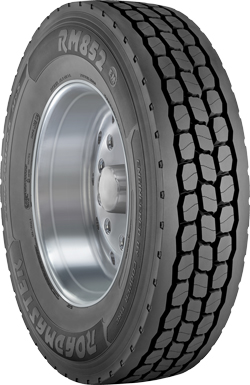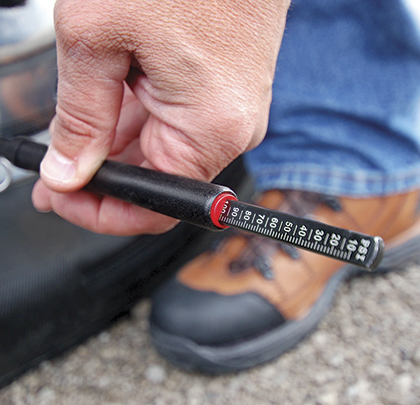Changes to Phase 2 greenhouse gas (GHG) regulations are coming in 2018 that will affect emission and fuel economy standards for medium- and heavy-duty vehicles. GHG regulations are designed to create cleaner, more fuel-efficient trucks by encouraging the wider use of currently available technologies and the development of new and advanced technologies through 2027.
Beginning in model year 2021, Phase 2 standards will also begin for vocational vehicles including cement and dump trucks. They will have increased stringency in model year 2024, and will be fully phased in by 2027. The EPA and National Highway Traffic Safety Administration (NHTSA) anticipate that the vocational vehicle standards could be met through improvements in the engine, transmission, driveline, low-rolling resistance tires, workday idle reduction technologies, weight reduction, and some use of hybrid technology.
TIRE MANAGEMENT
Mixed service operations should perform careful evaluations of the tires chosen for on- and off- highway trucks, in order to find the correct balance between long life, durability, and fuel economy. Vocational trucks cover a wide range of applications and are different from highway applications in that rolling resistance has not previously been a primary performance standard. Off-highway applications often require higher traction, deeper tread depths, increases in the void in the tread pattern, and resistance to cutting and chipping.
DESIGN OF LOW-ROLLING RESISTANCE TIRES
When a tire design achieves lower rolling resistance, it can result in undesirable side effects if the tires are not carefully engineered. For example, when some tire makers formulate tread compounds to achieve the lower rolling-resistance performance required for SmartWay verification, the tires may wear faster or be more susceptible to cutting and tearing than tires designed with more traditional tread compounds. Another typical difference is that SmartWay-verified tires, particularly drive tires, tend to have shallower tread depths. The shallower the tread depth, the less tread “squirm,” so a shallower tread depth at the start provides less rolling resistance for SmartWay verification. But, the disadvantage can be fewer overall miles to removal. However, Cooper Tires has engineered its SmartWay-verified Roadmaster tires to achieve a reduction in rolling resistance that exceeds the SmartWay criteria. In addition, the Roadmaster RM852(EM) closed shoulder and RM256(EM) open shoulder drive tires, for example, are designed with tread depths and compounds that offer comparable or even better performance than that of their non-SmartWay-verified counterparts.

Featured Image: Keeping tires in peak operating performance can add to fuel savings.
Above: Roadmaster RM852(EM)
Another consideration when evaluating the overall value of SmartWay-verified tires is the expected casing life—either for retreading or for a casing credit. All Roadmaster tires, including Roadmaster SmartWay-verified tires, come with a casing warranty of two retreads within 6 years.
LOW-ROLLING RESISTANCE FOR MIXED SERVICE
First and foremost, all tires need to hold up in their intended application. While the tread and compound design needed to achieve low-rolling resistance can sometimes run counter to the needs of off-highway vehicles, careful engineering and design enhancements can be made to the casing of the tire to make it operate with lower rolling resistance.
Every part of the tire design has some influence on rolling resistance, but the tread area has probably received the most attention, since that is what contacts the ground and is the most massive part of the tire. Tread compound changes have been widely used as a means to achieve reductions in rolling resistance in recent years. Low-rolling resistance tires have different tread rubber compounds and tread mass characteristics from standard tires to help them achieve reduced rolling resistance. The tread compounds tend to feature some silica in place of carbon black and polymers that are good for rolling resistance.
FUEL ECONOMY SAVINGS
One of the most important things to keep in mind is that low-rolling resistance tires can provide fuel savings. Using an estimated 3 percent fuel savings for a truck running 120,000 miles per year against a range of fuel efficiencies and fuel prices at the pump, the truck could expect to save 450-600 gallons of fuel per year, which translates to $1,350-$1,800 per year with a fuel price of $3 per gallon. For mixed service vehicles, low-rolling resistance tires can make good business sense.
As you can see, selecting low-rolling resistance tires that meet the needs of your fleet for on- and off-highway use requires careful evaluation. Roadmaster is available to consult with you about the needs for your fleet in on- and off-highway applications. ■
About the Author
Gary Schroeder is the director of Cooper’s truck and bus tire business, which includes the Roadmaster brand. For more information, visit www.roadmastertires.com.
_________________________________________________________________________
Modern Contractor Solutions, August 2017
Did you enjoy this article?
Subscribe to the FREE Digital Edition of Modern Contractor Solutions magazine.

Home Equipment Solutions Low-Rolling Resistance Tires Require Careful Consideration for Mixed Service Use
Low-Rolling Resistance Tires Require Careful Consideration for Mixed Service Use


